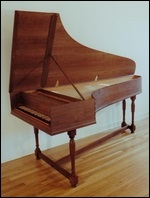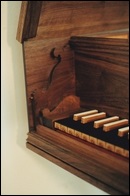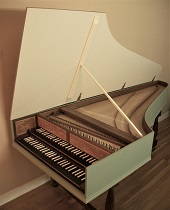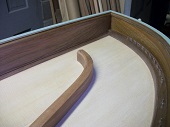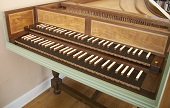  
 
   
 
 
 
 
  
P.O. Box 1163
Lemont, PA 16851
(814) 883-7799
damaple@comcast.net |  | 


Please click on images below for enlarged versions.
Harpsichord after Michael Mietke, Berlin, 1710
Scholars knew for many years that J.S. Bach had procured a harpsichord by Mietke for use at the court of Cöthen, but it was believed that no instruments by this maker had survived. In the mid 1980s, however, two highly-decorated, but unsigned, instruments in the Charlottenburg palace in Berlin were attributed to Mietke. A third signed instrument was later found in Sweden, verifying the attribution of the two in Berlin.
I currently offer a single-manual instrument in Mietke's style, based on the Swedish example. The case of the instrument uses a double-curved benstside, which probably reflects Mietke's interest in 17th-century French instruments. The stringing is in brass, and the sound is warm and direct, with moderate sustain.
The bass is fairly powerful, but with a less-pronounced resonance peak, compared to late French instruments. This is a versatile instrument that works well for a wide range of music, serving nicely as an alternative to the ubiquitous Franco-Flemish models.
Specification:
GG-d3, 8' 8'. Case in walnut, or with a painted finish (as in the original). 218 x 92 cm (86 x 36 in).

Harpsichord after Christian Zell, Hamburg, 1728.
The three surviving harpsichords by Christian Zell illustrate the somewhat eclectic nature of harpsichord making in northern Germany. Like other makers in that region, Zell used a double-curved bentside, again possibly reflecting some influence from certain 17th-century French makers. The shove coupler system, the jacks, and the layout of the iron-scaled string band are also not all that different from contemporary 18th-century French work, but the 8' bridges are distinctly taller and more massive. This difference, plus the very large dimensions of the double's case and soundboard, may contribute to its big, sustaining sound.
In the two Zell singles with simpler decorative schemes, the inner case rim above the soundboard is left unpainted, with an overhanging cap molding, giving the false impression of an inner case in the style of many contemporary Italian instruments. In this prototype for my rendition of the Zell double-manual design, I chose to veneer the inner case rim with black walnut in the false-inner-case style. (Being more highly decorated with an elaborate chinoiserie case, however, the inner rim of the 1728 double is painted red in the style of oriental lacquer work.) The interior framing of the Zell case also utilizes knees, in the Italian style, and another Italianate feature is the use of block registers for the jacks, rather than the separate upper and lower guides used in French and Flemish instruments.
The compass of Zell's singles is C-d3, while the range of the double is extended down chromatically to FF. The treble compass can be extended to f3 if desired, although the case of the double would then be exceptionally wide. Like harpsichords by other Hamburg makers, Zell's keywell surfaces receive a higher level of decoration, using veneers to create elaborate, inlaid panels. In my rendition, the keywell treatment features panels of figured and spalted pear, surrounded by bands of apple and walnut.
Specification:
FF-d3 (can be enlarged to f3), double manual, 8' 4' 8', shove coupler. Painted outer case and lid, with options for natural, veneered, or painted interior surfaces. Various options for keyboard coverings. 247 x 94 cm (97 x 37 in).
Price varies according to compass and decorative details. Please inquire for further information.

|


